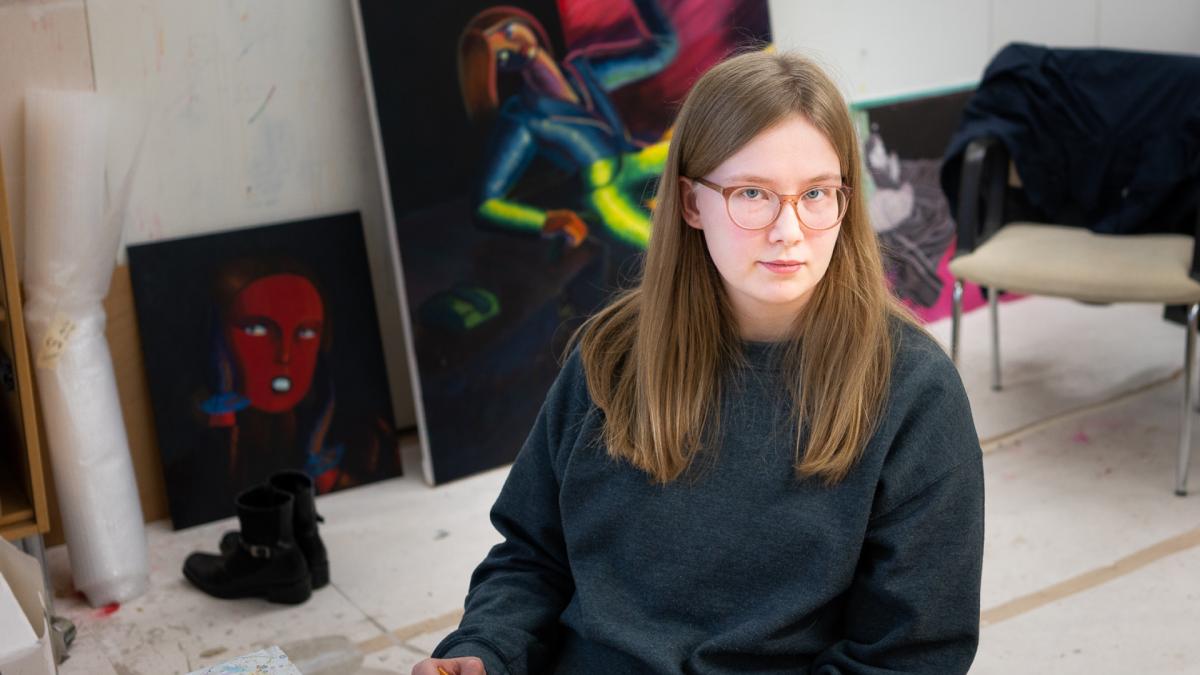Fine Arts degree student: It is important to hear what other people think about making art
Read an interview with Hanna Kytö.

Can you introduce yourself and describe how you ended up studying at Uniarts Helsinki?
I’m Hanna Kytö, a third-year Bachelor of Fine Arts student specialising in painting. I came across the university website when I was in middle school and dreaming of what I would be when I grow up. As a teenager, I used to browse the website a lot and search for information on art studies online. I was impressed by the idea of how anybody could become an artist.
I believed that if I drew enough and read enough about the field, I could eventually get to study art. After finishing school, I applied to study at Uniarts Helsinki three times. On my third attempt, I made it to the admissions process.
So, I had two gap years prior to attending Uniarts Helsinki: for the first year I studied fine arts at Lahti Folk High School and the second I spent drawing at home and working.
What was the admissions process like?
The entrance exams lasted six days, from Monday to Saturday. First, we received an assignment with very broad instructions. I was able to create pretty much anything as long as I could justify my choices to the entrance examination board and explain how the work was connected to the assignment.
Everyone who took part in the exams was given the exam material, which included a potato among other things. I came up with the idea of painting a picture of a man eating French fries at the back seat of a car. I thought my idea was funny and I think it made an impression on the entrance examination board, too.
How did you prepare for the admissions process?
It was important for me to feel confident in the admissions process. I knew that I might feel nervous about painting in the entrance exams and about seeing what kinds of artworks the other applicants were making.
Before the entrance exams, I bought wireless headphones and made myself a playlist so that I could listen to my favourite songs during the exam days. It also helped me to focus on nothing but my own work in the exams.
How would you describe your studies?
My studies have been extremely interesting and well-rounded. I like the fact that they consist of both independent work at the studio and conventional courses. I like that my schedule is a versatile combination of working in small groups, lectures, discussions and my own independent work.
Which courses or projects have you found the most memorable?
I really liked art history and art philosophy. These subjects have helped me to understand what has happened in the field of arts in the past centuries and decades. Art philosophy helped me to realise that it’s not just about painting and art-making, but that there are so many questions about artistry and the role of an artist in society that are bubbling underneath the surface.
I’ve also really liked the small-group seminars that we have every other Monday. We get to know each other’s work and studios in small groups. I think it’s important to hear what other people think about making art and about their own artworks. It gives me a broader understanding of what other artists in the field are doing in a very tangible way.
What is your typical day as a student like?
I may spend the morning at home on my laptop listening to a lecture or drawing sketches. Then, in the afternoon, I go on campus to draw a live model in the drawing room, for example. Sometimes I spend the entire school day at the studio and paint.
What is the best aspect of your studies?
The best part is my student mates and the constant support that I get from other students and from teachers. While working at the studio, I often stop to visit my friends to say hello and talk about our art. I also like studio visits. This is when a teacher or an artist who is visiting the academy comes to the studio and I get to discuss my painting with them. It’s great to have the opportunity to hear what other people think of my works. I usually paint a single painting for several months, so it feels refreshing to take a break from my own thoughts and hear another person’s impressions on my paintings. I keep a studio journal where I write down the best comments, so I can come back to them later.
What has been the most challenging aspect of your studies?
I’d say that challenges are a constant part of studies, but they can all be overcome. In the beginning, the hardest part was getting used to the new environment, but that particular problem faded away after the first few months. During my second year, I struggled with my artistic identity and reflected on the path that I wanted to take in my work. I wasn’t sure what I wanted to convey with my art. Now I’ve tackled that problem, too, but my new challenge is the upcoming Bachelor of Fine Arts degree show, which will be in the autumn next year. I think you can go far in your studies if you are solution-oriented and consider each new challenge an opportunity to discover something new.
What kind of advice do you have for future applicants?
Be yourself in the admissions process. Every single one of our students is different, there’s no specific “artist type” that you have to resemble to be able to be admitted to our school. Everyone has their own unique skills and perspectives, so it’s really important that you create exactly the kinds of artworks that you are inspired to create.